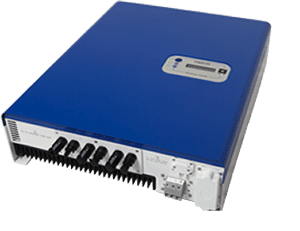
In the event of a problem with the SEA Orion Solar Inverter, the red fault LED will turn on, the green power light is off and the LCD will display a message identifying the cause of the fault. Take note of the fault to diagnose the problem in your SEA Orion Solar Inverter.
To easily determine the solutions to these faults, we have put together a list of LCD fault messages, diagnosis and solutions from the SEA Orion Inverter user’s manual. Please follow safety precautions before performing below procedures. It is also recommended that you contact a qualified electrician to assist you.
The following are descriptions on the common system and inverter faults on a SEA Orion Solar Inverter:
|
OPERATING CONDITIONS |
MESSAGE |
DESCRIPTION |
|
System Faults |
||
| Isolation failure | Isolation fault | There is an electrical fault between the PV panels or wiring and protective earth, or the input surge suppression circuitry on the SPG-360-2K0-1 has been damaged due to a lightning surge. This alarm will be displayed on initial application of PV power. The inverter will not attempt to connect to the AC mains grid until this fault is rectified. |
| GFCI active | Ground I Fault | There has been excessive leakage current from the PV array to the earth while the inverter was generating power. The inverter has disconnected from the grid due to this fault. |
| Grid failure | Grid Fault | The AC mains grid voltage or frequency is outside of limits (default 206V/264V, 49.25Hz/50.75Hz). The inverter has disconnected from the grid. |
| No utility | No utility | The AC mains grid is not available. There has been a mains power failure or the AC mains grid has been turned off. |
| Input voltage too high | PV over voltage | The input voltage VPV is greater than 500V on one of the inputs. |
|
Inverter Faults |
||
| Consistent failure | Consistent fault | The readings of the two internal microprocessors do not agree. |
| Temperature too high | Over temperature | Internal temperature is excessive. |
| Output relay failure | Relay failure | One of the grid connection relays is faulty. |
| Output DC injection too high. | DC INJ High | The inverter is generating excessive DC current on the AC mains grid. |
| EEPROM problem | EEPROM Failure | The EEPROM memory inside the inverter has a data access problem |
| Communication failure between microprocessors | SCI Failure | The communications between the two microprocessors has failed. |
| DC bus voltage too high | High DC Bus | The internal DC bus voltage is higher than expected. |
Here are the diagnoses and solutions to these faults:
|
Type |
LCD Message |
Diagnosis and Solution |
| System | Isolation Fault | 1. There is an electrical fault between the PV panels or wiring and protective earth or the input surge suppression circuitry on the SPG-360-2K0-1 has been damaged due to a lightning surge. 2. Turn off the PV array main switch, the solar supply main switch and the AC isolation device (if present). 3. Unplug the PV inputs from the inverter. 4. Turn on the PV array main switch. 5. Measure the following three voltages supplied by the PV array using a multimeter with a 10MΩ input resistance: a. PV+ to PV- b. PV+ to protective earth c. PV- to protective earth 6. Confirm that b+c is much less than a. 7. If b+c is approximately equal to a, there is an electrical fault in the array. Carefully inspect all PV panels and array wiring for damaged insulation. 8. Temporarily connect a 1kΩ 10W resistor between + and – on each inverter input. 9. With the 1kΩ resistors in 8 connected, check the DC resistances between each PV Wait until the voltages across these resistors are all less than 1V. |
| System | Ground I Fault | 1. There has been excessive leakage current from the PV array to the earth while the inverter was generating power. This fault can occur sometimes during heavy rainfall or if there is heavy condensation on the PV arrays, due to increased leakage currents between the arrays and earth via this water. If this is the case, once the array has dried off, the fault should clear. 2. If there has not been any water on the PV array, there is an electrical fault between the PV panels or wiring and protective earth or the input surge suppression circuit on the SPG-360-2K0-1 has been damaged due to a lightning surge. Perform the tests in “Isolation Fault” above. |
| System | Grid Fault | 1. Wait for 5 minutes. If the grid returns to normal, the inverter will automatically restart. 2. Measure the grid voltage and frequency and confirm that they are within the over/under voltage and over/under frequency limits for the inverter. The factory programmed limits are 264Vrms, 206Vrms, 50.75Hz and 49.25Hz respectively; however, the local utility may have required these to be changed at system commissioning |
| System | No Utility | 1. The AC mains grid has been disconnected. 2. Check that AC mains voltage is present at the main switchboard and the distribution board to which the SPG-360-2K0-1 is connected. 3. Check that the solar supply main switch and AC isolation device (if present) are turned on. 4. Check the connections to the inverter’s AC output cable. |
| System | PV over voltage | 1. Check that the PV input voltage is less than 500Vdc. 2. If less than 500Vdc and the fault persists, contact SEA service. |
| Inverter Fault | Over temperature | 1. Check that the inverter heat sink is clean and free from debris. 2. Reduce the ambient temperature by improving ventilation around the inverter. 3. If the fault persists, contact SEA service. |
| Inverter Fault | GFCI Failure | 1. Turn off the PV array main switch, the solar supply main switch and the AC isolation device (if present). 2. Leave these switches off for at least one hour. 3. Turn the PV array main switch, the solar supply main switch and the AC isolation device (if present) back on. The fault should reset. 4. If the fault persists, contact SEA service. |
| Inverter Fault | High DC Bus | 1. Check that the AC mains grid L (Active) and N (Neutral) leads have not been reversed. 2. Turn off the PV array main switch, the solar supply main switch and the AC isolation device (if present). 3. Leave these switches off for a few seconds. 4. Turn the PV array main switch, the solar supply main switch and the AC isolation device (if present) back on. The fault should reset. 5. If the fault persists, contact SEA service. |
| Inverter Fault | Consistent fault Relay failure DC INJ High EEPROM Failure SCI Failure Low DC Bus Ref 2.5V Fault DC Sensor Fault |
1. Turn off the PV array main switch, the solar supply main switch and the AC isolation device (if present). 2. Leave these switches off for a few seconds. 3. Turn the PV array main switch, the solar supply main switch and the AC isolation device (if present) back on. The fault should reset. 4. If the fault persists, contact SEA service. |
The full details are available in the SEA Orion Solar manual’s troubleshooting section. In case performing the steps above does not fix the issue and your SEA Orion Solar Inverter is still within the warranty period you can contact the equipment installer or supplier.
Please be prepared to describe the details of your system installation and provide the model and serial number of the unit. If your SEA Orion Solar Inverter is outside the warranty period we suggest that you contact a professional solar power expert. If you’re in the Gold Coast or Brisbane area contact Gold Coast Power Solutions here and we will be in touch to provide you with further assistance.
Got A Question About Solar Power?
- Can you add more solar panels to your solar power system?
- How much power can you expect from your solar power system?
- Do you know how to read your Energex solar power meter?
- How to make the most of the 44c feed in tariff
- How to make the most out of a low feed in tariff





